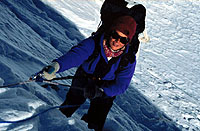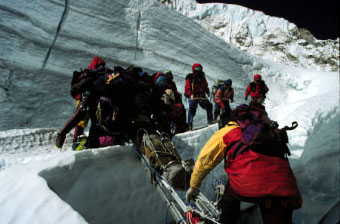
|
 |
 |
 Through the Icefall
Through the Icefallpart 5 | back to part 4 The Physical Truth at Base Camp The sun may be out, but if the wind picks up it'll chill you to the bone. When you're not cold, you're hot. There's hardly a happy medium as toes, fingers and extremities are always subject to the effects of a chilling wind. Living at altitude means a constant struggle with the cold. If you get a cut or your dry skin cracks, it won't heal until you descend. Colds and ailments linger, never improving with time, a constant reminder of the non-life-supporting environment you are in. Your health can destabilize here, never improving with time or rest. Stomach ailments abound, as the sometimes uncleanly cooking habits in Kathmandu or in the lodges on the way up can bring out the worst effects on the digestive system. But everyone experiences this at one time or another here, so it becomes accepted as commonplace. One of the marvels of Himalayan mountaineering, nonetheless, is that 3 months later we've forgotten all the pain, all the hardship, the cold, the coughs, the food, the danger, and we're itching to come back again. The Rescue  Although Camp 1 is officially established, David, Araceli,
Sumiyo, Jamling and Ed head up the Icefall with Sherpas to
carry up the final loads: tents, sleeping bags, pads, food,
and fuel for cooking will be needed there. It's a windy day at
Base but on the mountain the air is still and hot. We hear
over the radio that five Sherpas from another expedition were
sent to establish Camp 2. The Sherpa in front, who was not
roped in, fell in a crevasse covered with snow. He broke his
femur, was pulled out with rope by his teammates, and has been
stuck at Camp 1 for 2 days waiting for a rescue team to help
him down.
Although Camp 1 is officially established, David, Araceli,
Sumiyo, Jamling and Ed head up the Icefall with Sherpas to
carry up the final loads: tents, sleeping bags, pads, food,
and fuel for cooking will be needed there. It's a windy day at
Base but on the mountain the air is still and hot. We hear
over the radio that five Sherpas from another expedition were
sent to establish Camp 2. The Sherpa in front, who was not
roped in, fell in a crevasse covered with snow. He broke his
femur, was pulled out with rope by his teammates, and has been
stuck at Camp 1 for 2 days waiting for a rescue team to help
him down.The evacuation takes most of the day with the aid of about 35 people, including several of our Sherpas and climbers. They strap him to a ladder and each steep portion of fixed rope takes several hours to negotiate. An official request for a rescue helicopter from Kathmandu is radioed in, and people at Base Camp start clearing a landing pad. In extreme cases, helicopters will fly in to evacuate climbers, but this is no easy task since the helicopters find little lift for takeoff at such a high altitude. Each rescue is a dangerous undertaking for the pilots.  Our climbers come down tired and hungry and Ed comments on the
route: "The most worrisome area is the Icefall, but I guess
I'm becoming more comfortable with it because I know I can get
through it very quickly, and this year it's as safe as I've
ever seen it. I mean it's in really good condition. There's
only 1 or 2 places where you're in any immediate danger if
something were to collapse."
Our climbers come down tired and hungry and Ed comments on the
route: "The most worrisome area is the Icefall, but I guess
I'm becoming more comfortable with it because I know I can get
through it very quickly, and this year it's as safe as I've
ever seen it. I mean it's in really good condition. There's
only 1 or 2 places where you're in any immediate danger if
something were to collapse."Continue Photos: (1) courtesy Robert Schauer, (2) David Breashears, (3) Araceli Segarra . Lost on Everest | High Exposure | Climb | History & Culture | Earth, Wind, & Ice E-mail | Previous Expeditions | Resources | Site Map | Everest Home Editor's Picks | Previous Sites | Join Us/E-mail | TV/Web Schedule About NOVA | Teachers | Site Map | Shop | Jobs | Search | To print PBS Online | NOVA Online | WGBH © | Updated November 2000 |